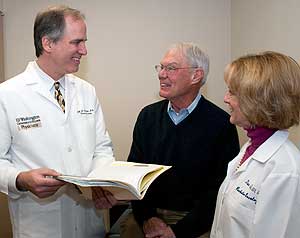Showing an appreciation for irony, radiation oncologist Jeff M. Michalski, M.D., says that as a physician he’s a generalist with a very specialized focus.

“I get to see patients of all ages, from the child who has a pediatric tumor to men in their 70s or 80s with prostate cancer,” Michalski says. “I see both genders and treat cancers in many different disease sites. I interact with head and neck surgeons, urologists, neurosurgeons, orthopedic surgeons and gynecologists. But because I treat patients using radiation, I focus on a specific and unique treatment modality.”
Michalski is vice chair and director of clinical programs in the Department of Radiation Oncology. He says conducting clinical trials to improve radiation therapy for cancer has been the defining aspect of his career.
Among his studies is a clinical trial designed to see if children with medulloblastoma, a highly malignant brain tumor, can be treated with a lower-than-usual dose of radiation, potentially sparing them from side effects such as hearing loss, pituitary dysfunction and spinal cord damage.
He just completed a study comparing high- and low-dose radiation therapy in men with prostate cancer. The preliminary results suggest that improved radiation delivery technology makes it possible to increase radiation to the tumor while at the same time reducing adverse side effects.
Those are just two examples of Michalski’s many past and current clinical investigations, which he conducts while maintaining a key role in standardizing the quality of radiation therapy used in clinical investigations.
“Jeff is internationally recognized for his expertise in prostate cancer,” says Jeffrey D. Bradley, M.D., the S. Lee Kling Associate Professor of Radiation Oncology. “But he is also well-known for his work in quality assurance to standardize radiation oncology techniques for both adult and pediatric cancer patients enrolled in clinical trials.”
Together with Walter Bosch, D.Sc., research assistant professor of radiation oncology, Michalski leads a consortium of quality-assurance institutions supporting radiation therapy clinical research in institutions in the United States, Canada, Europe, Japan and South America. The consortium is funded by one of the largest grants at the School of Medicine.
Career path
Michalski went to medical school at the Medical College of Wisconsin in Milwaukee. As a teenager and young adult, he had watched family members suffer from cancer, so he chose to go into oncology and settled on radiation oncology as a specialty.
A residency in radiation oncology at New York Presbyterian Medical Center in New York was followed by a residency and fellowship in the same field at the School of Medicine. Michalski joined the WUSTL faculty in 1991.
“Jeff started at Washington University as a resident, was hired as an attending and has risen steadily in the radiation oncology department,” says Daniel A. Low, Ph.D., director of the department’s Medical Physics Division and professor of radiation oncology. “He has been a wonderful friend and colleague.”

Wanting to take on a leadership role in the department, Michalski earned a master’s degree in business administration from Olin Business School in 2001.
“Going to business school was a difficult time,” he says. “I felt as if I didn’t have a day off, ever. I was either in school, at work or on the road for research meetings. But I believe the degree helps me understand the financial aspects of the job better.”
Michalski was named director of the Clinical Division in the department in 2002 and became a full professor in 2006. He served as the department’s interim head from 2008 until 2009, when he took on his present position.
In addition, he is the vice chair of the Radiation Therapy Oncology Group (RTOG), a multi-institutional cooperative organization funded by the National Cancer Institute. He also heads its advanced technology integration committee.
Progress in radiotherapy
Technological advances are rapidly changing radiotherapy. Equipment now can take into account slight shifts in the position of the patient’s body and internal organs. Michalski led the way for the department to adopt such technologies, which improve the precision of radiation treatments.
The implementation of image-guided radiation therapy in the department often lets physicians shorten the treatment time. Whereas in the past it might require six or seven weeks of radiation treatments for early-stage lung cancer, for example, radiation oncologists now can get a more effective dose to the tumor in a week or two.
Michalski supported a study done through the RTOG that showed very precise radiotherapy could be delivered in community practices as well as large medical centers and give the same tumor control as if a surgeon had removed the mass.
The ability to send digital information nearly anywhere also is making an important difference. Michalski says he can see how patients are being treated anywhere in the country or the world.
Of course, Michalski sees patients outside the virtual world, too. He spends two days a week in the clinic. When he consults with patients, he says he strives especially to describe all their treatment options fully so they can make decisions that are right for them.
|
Jeff M. Michalski |
|
Family: Wife, Sheila; children Basia, 19, Sophie, 17, and Jeffrey, 13 Education: B.S., biochemistry, University of Wisconsin-Madison; M.D., Medical College of Wisconsin; MBA, Washington University Titles: Vice chair and director of clinical programs in the Department of Radiation Oncology and professor of radiation oncology. As vice chair, Michalski oversees the Clinical Division of the Department of Radiation Oncology. The division includes clinical operations at all treatment facilities; clinical and translational research; and physician resident, fellow and medical student training and education. He also oversees the Brachytherapy Center, the Kling Center for Proton Therapy, the Gamma Knife Center and community and off-campus programs. |
“I want to make sure they get answers to all their questions,” he says. “If a patient comes in with a spouse or family member, I make sure they are included in the conversation. And we carefully discuss effects of the various therapies that may impact their quality of life.”
“Jeff has a rare ability to bridge the worlds of physics and medicine, and he continues to take a leading role in the testing of new technology in clinical trials,” says Joseph O. Deasy, Ph.D., professor of radiation oncology. “He has been a terrific partner to physicists like me and other researchers in radiation oncology.”
His patients and administrative responsibilities demand a great deal of Michalski’s time, and his research and oversight duties take him away from St. Louis frequently, but his family is the bedrock of his life.
At home
He and his wife, Sheila, have three children. Sheila Michalski is a clinical research monitor and audits trials at academic medical centers, so she sees research studies from the opposite side as her husband. Jeff Michalski says that gives each of them great insight into the other’s workday.
“Jeff is a dedicated husband and father — his three children have loads of activities and friends,” Bradley says. “It seems like every time we go to the Michalski house, there are several teenagers around, answering the door and the phone and raiding their refrigerator. This is a terrific family!”
“I do think we have a special family,” Michalski says. “We make a point of eating as a family as often as we can. We sit down and talk about our day. My wife and I travel a lot, but whenever we are home, we’re together for dinner.”
Michalski is the main cook in the family, and he considers cooking one of his hobbies, often improvising a quick meal based on what looked best at the grocery store. Recently, he has discovered the enjoyment of bread-making and can cite from memory a recipe for no-knead bread that he says is as good as any bread at Saint Louis Bread Co.
The recipe calls for a little beer for a yeasty flavor. If he wished, Michalski could add a bit of his own home brew. He has won several beer-brewing competitions, including some national championships. A French-Belgian sour beer of his recently took first place in a master’s championship of amateur brewers.
His hometown of Milwaukee is known as the beer capital of the world, so beer-making is a natural for him. But it also taps into his educational background.
“Think about it — Milwaukee, St. Louis, bread, beer — it’s all about the yeast. I was a biochemistry major as an undergraduate, and it’s frustrating not to get to use the principles I learned about — beer-making lets me do that,” he says, only half joking.